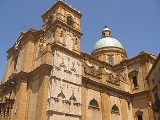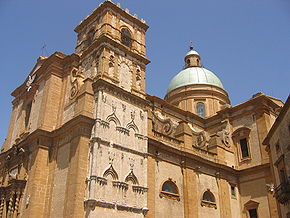
Piazza Armerina
Encyclopedia
Piazza Armerina is an Italian
comune
in the province of Enna
of the autonomous island region of Sicily
.
times, as showed by the notable mosaics at the patrician Villa Romana del Casale
.

, about 3 km to the southwest. It has a range of significant architecture dating from medieval through the 18th century. The discovery and excavation of the well-preserved, highly refined mosaics has helped attract tourists.
The medieval history of the city is manifest in some of its houses, which show Norman
or Gothic architecture
. The main landmarks include a range of architectural styles:
Outside the city is the ancient church of the Priorato di Sant'Andrea (1096), founded by Count Simon of Butera, a nephew of Roger I of Sicily
. It has important medieval frescoes.
, and the subsequent repopulation by William II
(according to other scholars, during the slightly later age of Frederick II
) with colonists coming from "Lombard
" regions of northern Italy, especially from Monferrato and Piacenza
.
Italy
Italy , officially the Italian Republic languages]] under the European Charter for Regional or Minority Languages. In each of these, Italy's official name is as follows:;;;;;;;;), is a unitary parliamentary republic in South-Central Europe. To the north it borders France, Switzerland, Austria and...
comune
Comune
In Italy, the comune is the basic administrative division, and may be properly approximated in casual speech by the English word township or municipality.-Importance and function:...
in the province of Enna
Province of Enna
Enna is a province in the autonomous island region of Sicily in Italy. Its capital is the city of Enna.It has an area of 2,562 km², and a total population of 177,200 . There are 20 comunes in the province, see Comunes of the Province of Enna...
of the autonomous island region of Sicily
Sicily
Sicily is a region of Italy, and is the largest island in the Mediterranean Sea. Along with the surrounding minor islands, it constitutes an autonomous region of Italy, the Regione Autonoma Siciliana Sicily has a rich and unique culture, especially with regard to the arts, music, literature,...
.
History
The city of Piazza (as it was called before 1862) originated during the Norman domination in Sicily (11th century), but the area was inhabited since prehistoric times. The city was flourishing also during RomanAncient Rome
Ancient Rome was a thriving civilization that grew on the Italian Peninsula as early as the 8th century BC. Located along the Mediterranean Sea and centered on the city of Rome, it expanded to one of the largest empires in the ancient world....
times, as showed by the notable mosaics at the patrician Villa Romana del Casale
Villa Romana del Casale
Villa Romana del Casale is a Roman villa built in the first quarter of the 4th century and located about 5 km outside the town of Piazza Armerina, Sicily, southern Italy...
.

Main sights
The town is famous chiefly for its Roman mosaics in the Villa Romana del CasaleVilla Romana del Casale
Villa Romana del Casale is a Roman villa built in the first quarter of the 4th century and located about 5 km outside the town of Piazza Armerina, Sicily, southern Italy...
, about 3 km to the southwest. It has a range of significant architecture dating from medieval through the 18th century. The discovery and excavation of the well-preserved, highly refined mosaics has helped attract tourists.
The medieval history of the city is manifest in some of its houses, which show Norman
Norman architecture
About|Romanesque architecture, primarily English|other buildings in Normandy|Architecture of Normandy.File:Durham Cathedral. Nave by James Valentine c.1890.jpg|thumb|200px|The nave of Durham Cathedral demonstrates the characteristic round arched style, though use of shallow pointed arches above the...
or Gothic architecture
Gothic architecture
Gothic architecture is a style of architecture that flourished during the high and late medieval period. It evolved from Romanesque architecture and was succeeded by Renaissance architecture....
. The main landmarks include a range of architectural styles:
- The massive BaroqueBaroqueThe Baroque is a period and the style that used exaggerated motion and clear, easily interpreted detail to produce drama, tension, exuberance, and grandeur in sculpture, painting, literature, dance, and music...
Cathedral (17th-18th century), built on the 15th-century foundations of a former church, from which the bell tower was taken and reused. Also original to the 15th c. church are the Catalan-Gothic style windows on the left side. The dome dates from 1768. The façade has a notable portal with spiral columns by Leonardo De Luca. The interior, with a single large nave, houses the Madonna della Vittoria (Madonna of the Victory). The ByzantineByzantineByzantine usually refers to the Roman Empire during the Middle Ages.Byzantine may also refer to:* A citizen of the Byzantine Empire, or native Greek during the Middle Ages...
icon is traditionally associated with the banner donated by the PopePopeThe Pope is the Bishop of Rome, a position that makes him the leader of the worldwide Catholic Church . In the Catholic Church, the Pope is regarded as the successor of Saint Peter, the Apostle...
to Roger I of SicilyRoger I of SicilyRoger I , called Bosso and the Great Count, was the Norman Count of Sicily from 1071 to 1101. He was the last great leader of the Norman conquest of southern Italy.-Conquest of Calabria and Sicily:...
during the Council of Melfi. The cathedral has an unusual two-sided crucifixCrucifixA crucifix is an independent image of Jesus on the cross with a representation of Jesus' body, referred to in English as the corpus , as distinct from a cross with no body....
by an unknown artist. The Diocesan Museum holds reliquiaries, articles of silverware, monstranceMonstranceA monstrance is the vessel used in the Roman Catholic, Old Catholic, and Anglican churches to display the consecrated Eucharistic host, during Eucharistic adoration or Benediction of the Blessed Sacrament. Created in the medieval period for the public display of relics, the monstrance today is...
s and other religious art works. - The nearby Palazzo Trigona, house of the wealthy family who commissioned the church.
- The Church of Fundrò, known also as St. Roch, with a carved tufa portal.
- The nearby Palazzo di Città (1613), characterized by a fresco ceiling by Salvatore Martorana.
- The massive Aragonese Castle (1392–96). It is square in shape, with square towers.
- The church of San Giovanni Evangelista (14th century), with an interior covered with frescos by Guglielmo BorremansGuglielmo BorremansGuglielmo Borremans was a painter, born in Antwerp. He was mainly active in Italy, especially in Naples and Sicily, where he frescoed the walls and ceilings of several churches.- Life :...
and assistants. - The baroque church of Sant'Anna (18th century), with its original sinuos facade inspired by the buildings of Borromini.
- The church of St. Martin of Tours (1163).
- The church of Santa Maria di Gesù (16th century), now abandoned.
- The Garibaldi TheatreGaribaldi Theatre (Piazza Armerina)The Garibaldi Theatre is a a theatre in Piazza Armerina, Sicily, southern Italy.The theater was built to the east, close to the 14th century wall, opposite the church of St. Stephen. Built in the 18th century, it has a Renaissance style façade designed in 1902. It can house a total of 320...
.
Outside the city is the ancient church of the Priorato di Sant'Andrea (1096), founded by Count Simon of Butera, a nephew of Roger I of Sicily
Roger I of Sicily
Roger I , called Bosso and the Great Count, was the Norman Count of Sicily from 1071 to 1101. He was the last great leader of the Norman conquest of southern Italy.-Conquest of Calabria and Sicily:...
. It has important medieval frescoes.
Culture
Piazza Armerina holds an annual Palio dei Normanni, a re-enactment in costume of the entrance of the Norman Count Roger I to the city. It takes place on 12–14 August.Language
Piazza Armerina is one of the so-called "Lombardic" communes of Sicily, as its dialect differs notably from that of the neighbouring region. This is due to the destruction of the old Piazza by king William I of SicilyWilliam I of Sicily
William I , called the Bad or the Wicked, was the second king of Sicily, ruling from his father's death in 1154 to his own...
, and the subsequent repopulation by William II
William II of Sicily
William II , called the Good, was king of Sicily from 1166 to 1189. William's character is very indistinct. Lacking in military enterprise, secluded and pleasure-loving, he seldom emerged from his palace life at Palermo. Yet his reign is marked by an ambitious foreign policy and a vigorous diplomacy...
(according to other scholars, during the slightly later age of Frederick II
Frederick II, Holy Roman Emperor
Frederick II , was one of the most powerful Holy Roman Emperors of the Middle Ages and head of the House of Hohenstaufen. His political and cultural ambitions, based in Sicily and stretching through Italy to Germany, and even to Jerusalem, were enormous...
) with colonists coming from "Lombard
Lombardy
Lombardy is one of the 20 regions of Italy. The capital is Milan. One-sixth of Italy's population lives in Lombardy and about one fifth of Italy's GDP is produced in this region, making it the most populous and richest region in the country and one of the richest in the whole of Europe...
" regions of northern Italy, especially from Monferrato and Piacenza
Piacenza
Piacenza is a city and comune in the Emilia-Romagna region of northern Italy. It is the capital of the province of Piacenza...
.

